Written by Tariq Ramadan, a fellow at St. Antony’s, this statement about his lengthy troubles with trying to get a US visa is well worth reading. In part, he says:
I fear that the United States has grown fearful of ideas. I have learned firsthand that the Bush administration reacts to its critics not by engaging them, but by stigmatizing and excluding them. Will foreign scholars be permitted to enter the United States only if they promise to mute their criticisms of U.S. policy? It saddens me to think of the effect this will have on the free exchange of ideas, on political debate within America, and on our ability to bridge differences across cultures.
This hits straight at what I see as the biggest foreign policy problem in the United States. It is not the holding of convictions; nor is it the willingness to act upon them. It is willful ignorance and self-delusion applied to information that contradicts the existing stance of the administration. While this trend extends into domestic politics, the most stark examples exist in the area of foreign affairs.
It is fair enough to argue that, at the time of the invasion of Iraq, Saddam Hussein was widely considered a threat. This is a judgement that was not confined to the British and American intelligence services. The British and American administrations could say: “We may have been wrong, but we were honest in our beliefs.” To say, instead, that they have been right all along, or deny making claims that have been undeniably recorded makes you them either insane or cynically disinterested in the truth. The indictment here is not based on the truth or falsehood of the original claims, but on the unwillingness of a group of people to revise their positions, or even admit fault, when facts have proved them wrong.
When an intelligence report confirmed the absence of WMD at the same time as the administration was claiming that the report said the opposite, Jon Stewart cleverly remarked:
The official CIA report, the Duelfer Report, has come out. The one that they’ve been working on for the past two years that will be the definitive answer on the weapons of mass destruction programs in Iraq, and it turns out, uh, not so much. Apparently, there were no weapons of mass destruction in Iraq, and their capabilities had been degraded, and they pretty much stopped trying anything in ’98. Both the President and the Vice President have come out today in response to the findings and said that they clearly justify the invasion of Iraq. So, uh, some people look at a glass and see it as half full, and other people look at a glass and say that it’s a dragon.
A notorious example of the trend of denying past statements is Donald Rumsfeld on WMD: “We know where they are. They’re in the area around Tikrit and Baghdad and east, west, south and north somewhat.” on ABC’s This Week With George Stephanopoulos, 30 March 2003. When challenged, Rumsfeld has repeatedly denied having ever claimed certainty about the existence of Iraqi WMD. Dick Cheney has likewise lied about previous statements (example) in which he claimed that such weapons certainly existed. Numerous other examples are obvious: the administration has misjudged the seriousness of the Iraqi insurgency, entirely miscategorized the relationship between the former Iraqi leadership and Al Qaeda, and continually misrepresented the human rights records of friendly but abusive regimes, including Saudi Arabia and Pakistan.
While politics has never been a discipline where practitioners adhere closely to the truth (look at Taylor Owen’s article in this month’s Walrus about the scale of US bombing in Cambodia during the Johnson administration), there are times when the disjoint between official statements and observable reality becomes so broad as to indict all of those who cling to the former. The fact that the run-up to the mid-term elections is being dominated by a scandal that, while disturbing, is quite peripheral to the governmental record of the dominant party demonstrates how narrow and polarized political debate has become.
Let us hope that, whatever the results are, the November 7 midterm elections will lead to a more candid discussion of the most pressing issues regarding America’s place and actions in the world.



